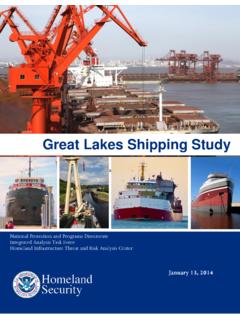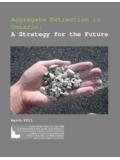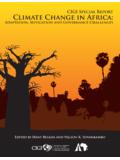Transcription of Which Fields Pay, Which Fields Don’t? An Examination of ...
1 Which Fields Pay, Which Fields Don t? An Examination of the Returns to University Education in Canada by Detailed Field of study Alan Stark1 Economic Studies and Policy Analysis Division Department of Finance, Canada February 2007 1 The views expressed in this paper are my own and should not be attributed to the Department of Finance. 1 Abstract The decision to attend university has a significant impact on an individual s lifetime earnings, as does his choice of field of study and whether or not to pursue graduate studies. This paper uses data from the 1996 Canadian Census to compute estimates of the private rate of return associated with these choices.
2 Use of data from the full (20 per cent) sample allows for estimates to be computed by detailed field of study . We find that the heterogeneity in rates of return across major Fields of study documented in previous research is found to persist within more narrowly defined Fields of study . We find rates of return to bachelor s degrees to be positive for all detailed Fields of study ; thus, they represent a sound investment. The same holds true for the vast majority of individuals pursuing graduate degrees. Additionally, use of 2002-03 tuition fee data indicates that recent increases in tuition fees has a noticeable, but not overwhelming, impact on rates of return; no field that was profitable under the 1995-96 cost structure is rendered unprofitable despite substantial increases in costs.
3 2 1. Introduction The decision to attend university has a significant impact on an individual s lifetime earnings, as does his choice of field of study and whether or not to pursue graduate studies. These choices are the focus of this paper. It should be noted that it is not the intent of this paper to model the educational choices of individuals per se, but rather to examine the returns associated with these Specifically, we use data from the 1996 Census to compute estimates of the private rate of return accruing to university graduates in Canada with different levels of university education. In doing so we consider both the direct costs (tuition fees and non-fee costs) and indirect costs (foregone earnings) of pursuing university, as well as the impacts of income taxes.
4 Use of data from the 20 per cent sample of the Canadian Census allows for estimates to be computed by detailed field of We wish to make it clear from the outset that we fully recognize that pecuniary rewards are not the only factors influencing a person s educational choice; they may not even be the primary factor. Nevertheless, it is reasonable to believe that individuals are concerned with the financial returns to education. Perhaps not so much that they choose the education path that will yield them the highest return, but at least to verify that a given choice will satisfy some idiosyncratic threshold. This is expected to be particularly true of persons deciding whether or not to pursue graduate work.
5 The rest of this paper will proceed as follows. Section 2 presents a brief discussion of the literature. Section 3 describes the methodology employed in the analysis and Section 4 describes the data. Construction of earnings profiles is discussed in Section 5. Section 6 presents results and Section 7 examines the sensitivity of these returns to increases in tuition fees. Conclusions and future work are presented in Section 8. 2. Literature Review When discussing returns to education, one must be careful regarding terminology. What exactly is meant by returns to education ? An individual considering investing in 2 Boudarbat and Lemieux (2003) provides an example of a study that models field of study as an endogenous choice.
6 3 Each time the Canadian census is conducted, 80 per cent of respondents complete the short-form Which asks only for demographic information. However, 20 per cent of respondents complete the long-form, Which collects additional data including information pertaining to earnings and educational attainment. The Census public use file, representing approximately 3 per cent of respondents, presents educational attainment only by major field of study , whereas the 20 per cent sample presents field of study by the more narrowly defined detailed field of study . 3education is primarily concerned with how they themselves will be directly affected by the investment. Thus, the measure of greatest interest to them is likely to be the private rate of return, Which considers only the benefits and costs that accrue solely to the individual.
7 Alternatively, returns to education may be examined within a broader context, namely, from the viewpoint of society as a whole. In this case, it is more appropriate to examine the total rate of return (sometimes referred as the public return), Which considers all the direct costs and benefits accruing to society, both private and public. A related concept is the social rate of return to education, Which like the total return, considers all the direct benefits and costs associated with investments in education, but also considers any externalities resulting from the production of education such as reduced crime, improved health and longevity, and human capital-driven endogenous growth.
8 If schooling is a productive investment rather than a signalling or screening device, then in the absence of externalities the total rate of return coincides with the social rate of return. However, if higher investment in human capital produces positive externalities, then the social rate of return will exceed the total rate of return. There are a number of studies that estimate private and total rates of return to post-secondary education in There are fewer studies that estimate social returns to education [see Moretti (2004) and Davis (2003) for examples].5 This paper most closely resembles four other studies: Vaillancourt (VA) (1995), Stager (ST) (1996), Rathje and Emery (RE) (2002) and Vaillancourt and Bourdeau-Primeau (VBP) (2002).
9 Each of these studies uses census data to estimate private and total rates of return to university education in They also examine similar time frames: together VA and VBP examine data from the 1986, 1991 and 1996 censuses, as does RE. ST confines his attention to the 1991 census. Accordingly, these papers shall be our primary points of reference. However, there are important differences between these studies and our own Which shall be discussed in more detail later. This being said, the results from these studies indicate that rates of return can vary substantially across the broadly defined major field of study , for example, between a bachelor s degree in one of the social sciences and a bachelor s degree in an engineering field.
10 But does this heterogeneity across major Fields of study also exist within Fields ? How does the return to a degree in economics compare to the return to a degree in sociology? A primary goal of this paper is to examine private rates of return by the more 4 Vaillancourt (1995) and Vaillancourt and Bourdeau-Primeau (2002) provide detailed summaries of the studies in this area. More recent studies include, but are not restricted to Appleby et. al. (2002). In related studies, Finnie (2002a, 2002b) examines early labour market outcomes of university graduates. 5 Readers of studies on returns to education must be careful when faced with the term social return as this term is sometimes used interchangeably with the term total return.
















